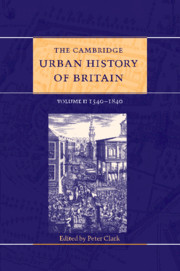Book contents
- Frontmatter
- 1 Introduction
- Part I Area surveys 1540–1840
- Part II Urban themes and types 1540–1700
- Part III Urban themes and types 1700–1840
- 14 Urban growth and economic change: from the late seventeenth century to 1841
- 15 Population and society 1700–1840
- 16 Politics and government 1700–1840
- 17 Culture and leisure 1700–1840
- 18 The transformation of urban space 1700–1840
- 19 London 1700–1840
- 20 Regional and county centres 1700–1840
- 21 Ports 1700–1840
- 22 Small towns 1700–1840
- 23 Health and leisure resorts 1700–1840
- 24 Industrialising towns 1700–1840
- 25 Conclusion
- Select Bibliography
- Index
- References
25 - Conclusion
from Part III - Urban themes and types 1700–1840
Published online by Cambridge University Press: 28 March 2008
- Frontmatter
- 1 Introduction
- Part I Area surveys 1540–1840
- Part II Urban themes and types 1540–1700
- Part III Urban themes and types 1700–1840
- 14 Urban growth and economic change: from the late seventeenth century to 1841
- 15 Population and society 1700–1840
- 16 Politics and government 1700–1840
- 17 Culture and leisure 1700–1840
- 18 The transformation of urban space 1700–1840
- 19 London 1700–1840
- 20 Regional and county centres 1700–1840
- 21 Ports 1700–1840
- 22 Small towns 1700–1840
- 23 Health and leisure resorts 1700–1840
- 24 Industrialising towns 1700–1840
- 25 Conclusion
- Select Bibliography
- Index
- References
Summary
walking the streets of Birmingham for the first time in 1803, John Francis, a Nottinghamshire lad, ‘gazed and stared at everything that he saw that his eyes were bloodshot … and his mouth being open … he was almost choked with dust’. Such wonder at the sight of early nineteenth-century British towns was not confined to poor folk up from the country. The Franco-American businessman, Louis Simond, ‘approached Leeds at night and from a height, north of the town, we saw a multitude of fires issuing, no doubt from furnaces, and constellations of illuminated windows (manufactories) spread over the dark plain’. Streets of good-looking shops, the vast, fire-proof clothiers’ hall, the merchants’ walk, the hospital with its good order and cleanliness, the library, and the many houses, a great part ‘modern and comfortable, with gardens, planted squares, and flowers in every window’, all impressed him.
A bird’s eye view of the island’s cities and towns on the accession of Victoria would have seen them progressively bound together by the sinuous chains of navigable rivers, canals, improved roads and the new railways (see Plate 31), carrying unprecedented volumes of commercial and other traffic. Less visible but no less vital for integrating the urban system were the links forged by capital markets, by the growing postal system, by the London and provincial press, and by the imperative of cultural fashion. Certainly the British urban system had advanced dramatically over the period, particularly since the seventeenth century. This is in marked contrast to other parts of Europe, where early advanced urban networks (as in the southern Netherlands) had suffered major reverses and only started to revive towards the end of our period; or where (as in the case of the Dutch Randstad) highly integrated city systems actually deurbanised in the late eighteenth and early nineteenth centuries; or where, as in France, many cities were in decline after the French Revolution; or where, as in Scandinavia, towns were only slowly waking up from a bucolic past.
- Type
- Chapter
- Information
- The Cambridge Urban History of Britain , pp. 831 - 836Publisher: Cambridge University PressPrint publication year: 2000



